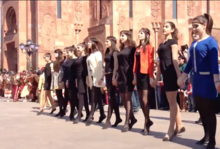Kochari
 Young Armenians dancing kochari in Yerevan | |
| Native name | Քոչարի |
|---|---|
| Genre | Folk dance Circle dance |
| Origin | Armenia |
| Kochari, traditional group dance | |
|---|---|
| Country | Armenia |
| Domains | Folk dance |
| Reference | 01295 |
| Region | Europe and North America |
| Inscription history | |
| Inscription | 2017 (12th session) |
| List | Representative |
Kochari(Armenian:Քոչարի,romanized:K’očari;Azerbaijani:Köçəri;Greek:Κότσαρι,romanized:Kόtsari;Turkish:Koçari) is afolk danceoriginating in theArmenian Highlands.[1]It is performed today byArmenians,[2][3][4]while variants are performed byAssyrians,[5]Azerbaijanis,[6][7]andPontic Greeks.[8]It is a form ofcircle dance.
Each region in theArmenian Highlandshad its own Kochari, with its unique way of both dancing and music.[9]
Etymology
- InArmenian,"Kochari" literally means "knee-come". Գուճ (gudj or goudj) means "knee" and արի (ari) means "come".[10][page needed]
- InAzerbaijani Turkish,"köç" means "to move" used both as a verb and as a noun,[11]with the latter used more in the context of nomads' travelling. "Köçəri" is also both an adjective and a noun, meaning a "nomad" and "nomadic" simultaneously.[12]
- InPontic Greek,from theGreek"κότσι" (in Pontic Greek "κοτς" ) meaning "heel" (fromMedieval Greek"κόττιον" meaning the same) and "αίρω" meaning "raise", all together "raising the heel", since the Greeks consider the heel to be the main part of the foot which the dancer uses.[citation needed]
Versions
John Blackingdescribes Kochari as follows:
Group dancing, when dancers imitate jumping goats, is known as kochari. Dancers stand abreast, holding each other's hands, The tempo of the dance ranges from moderate to fast. Squatting and butting an imagined opponent are followed by high jumps.[13]
Armenian

Armenians have been dancing Kochari for over a thousand years.[14]The dance is danced by both men and women and is intended to be intimidating. More modern forms of Kochari have added a "tremolo step", which involves shaking the whole body. It spread to the eastern part of Armenia after theArmenian genocide.The Armenian Kochari has been included to theList of Intangible Cultural Heritage in Need of Urgent SafeguardingofUNESCOin 2017.[15]
Azerbaijani
Today this dancing is played in the Nakhchivan land of whichSharur,Sadarak,Kangarli,JulfaandShahbuzregions' folklore collectives and it is performed at weddings.[16]Kochari along with tenzere has been included to the list of Intangible Cultural Heritage in Need of Urgent Safeguarding of UNESCO in November 2018 as versions of Yalli dance.[17][7]
Pontic Greek Kόtsari
ThePontic GreeksandArmenianshave many vigorous warlike dances such as the Kochari.[18]
Unlike most Pontic dances, the Kotsari is in an even rhythm (2
4), originally danced in a closed circle.[19]
See also
Gallery
-
Kochari dance in Aznavour Square
-
Kochari dance in Aznavour Square
-
Kochari dance in Aznavour Square
References
- ^"Kochari".Bennet Pilgrimages. 11 April 2014.Retrieved11 December2023.
- ^Elia, Anthony J. (2013)."Kochari (Old Armenian Folk Tune) for Solo Piano".Center for Digital Research and ScholarshipatColumbia University.doi:10.7916/D8S75QNP.Retrieved6 November2013.
{{cite journal}}:Cite journal requires|journal=(help) - ^Vvedensky, Boris, ed. (1953).Great Soviet Encyclopedia(in Russian). Vol. 23 (Second ed.). Moscow: Soviet Encyclopedia. p.170.
КОЧАРИ — армянский народный мужской танец.
- ^Yuzefovich, Victor (1985).Aram Khachaturyan.New York: Sphinx Press. p. 217.ISBN9780823686582.
..and in the sixth scene one of the dances of the gladiators is very reminiscent of Kochari, the Armenian folk dance.
- ^BetBasoo, Peter Pnuel (30 April 2003)."Thirty Assyrian Folk Dances"(PDF).Assyrian International News Agency.Retrieved6 November2013.
- ^Gottlieb, Robert(26 July 1998)."Astaire to Zopy-Zopy".New York Times.Archived fromthe originalon 21 September 2013.Retrieved6 November2013.
I find it difficult to imagine someone without a predisposition to read about such matters as Azerbaijani folk dance (One type of yally has various forms known as kochari, uchayag, tello, and galadangalaya; another type is a dance mixed with games called gazy-gazy, zopy-zopy, and chopu-chopu) browsing profitably through Oxford's many hundreds of pages of such information.
- ^ab"Yalli (Kochari, Tenzere), traditional group dances of Nakhchivan - intangible heritage - Culture Sector - UNESCO".ich.unesco.org.Retrieved2018-11-29.
- ^"Kotsari".Pontian.info. Archived fromthe originalon 16 October 2012.Retrieved6 November2013.
- ^Soviet Armenian EncyclopediaVolume 4(in Armenian). Yerevan: Armenian Encyclopedia Publishing. 1978. p.476.
- ^Cholakean, Hakob (2016).Ավանդական ուղղագրություն.Yerevan.
{{cite book}}:CS1 maint: location missing publisher (link) - ^KÖÇ
- ^KÖÇƏRİ
- ^Blacking, John (1979).The Performing Arts: Music and Dance.Walter de Gruyter. p. 71.ISBN9789027978707.
- ^Kochari // Music encyclopedic dictionary / Yu.V. Keldysh, M.G. Aranovsky, L.Z. Korabelnikova — Great Soviet Encyclopedia, 1990. — p. 275.
- ^"Kochari, traditional group dance".UNESCO.Retrieved5 December2020.
- ^"The National Dancings".Nakhchivan Autonomous Republic.Retrieved6 November2013.
- ^"Intangible Heritage: Seven elements inscribed on the List in Need of Urgent Safeguarding".UNESCO.Retrieved2018-11-29.
- ^Greece- Page 67 by Paul Hellander, Kate Armstrong, Michael Clark, Des Hannigan, Victoria Kyriakopoulos, Miriam Raphael, Andrew Ston
- ^"Kotchari".Pontos World.10 November 2019.
External links
- Kochari music -Armenian sample;Assyrian sample;Archived2007-08-09 at theWayback MachinePontic sample;Turkish sample
- Kochari dance -UNESCO video




